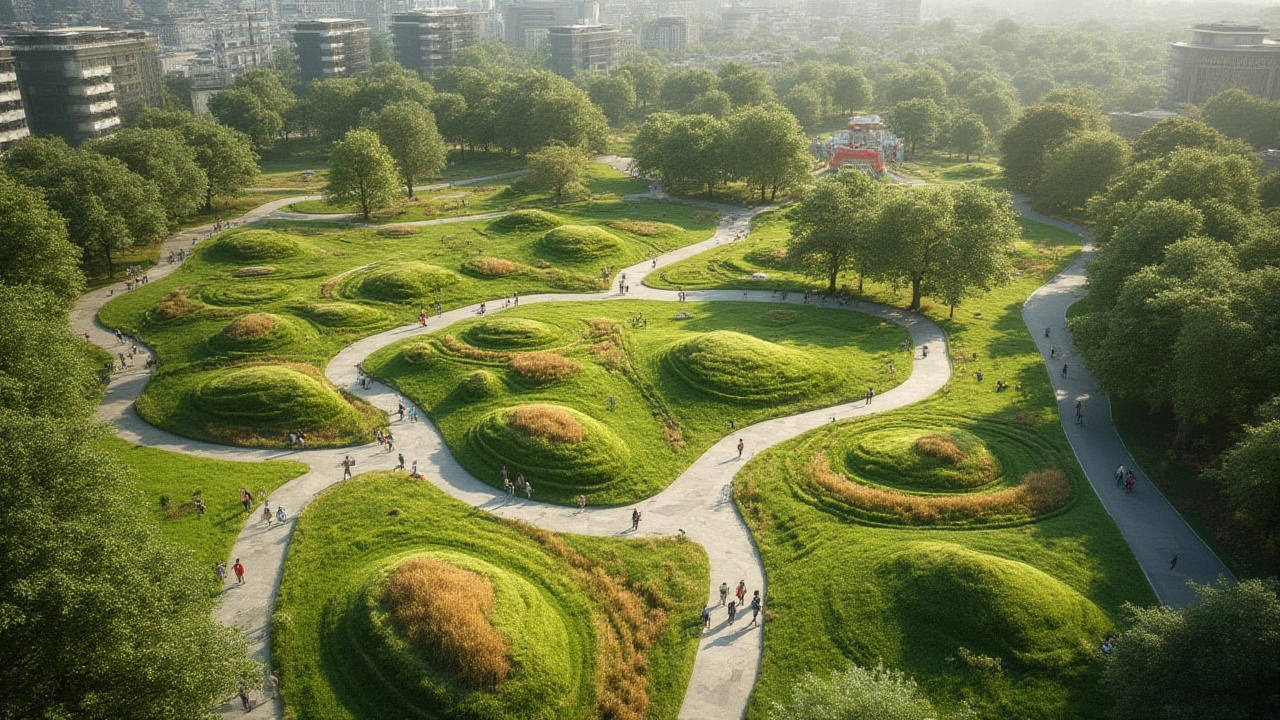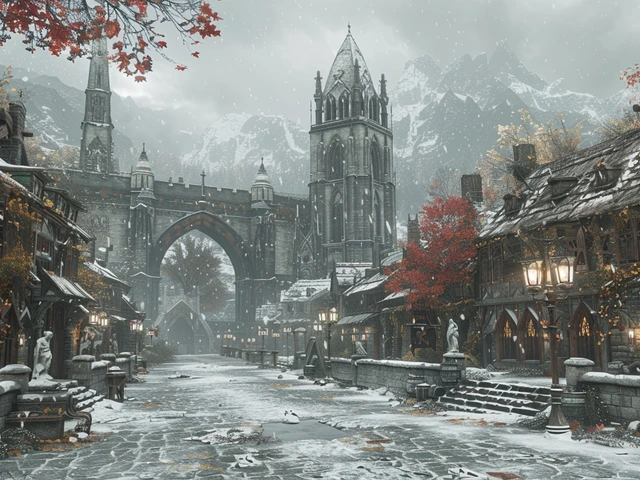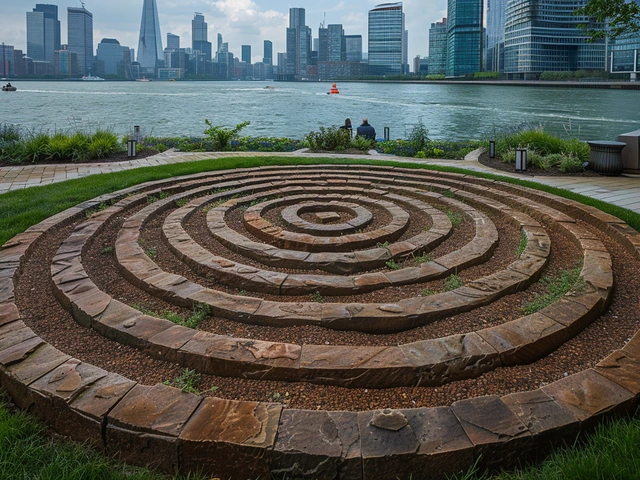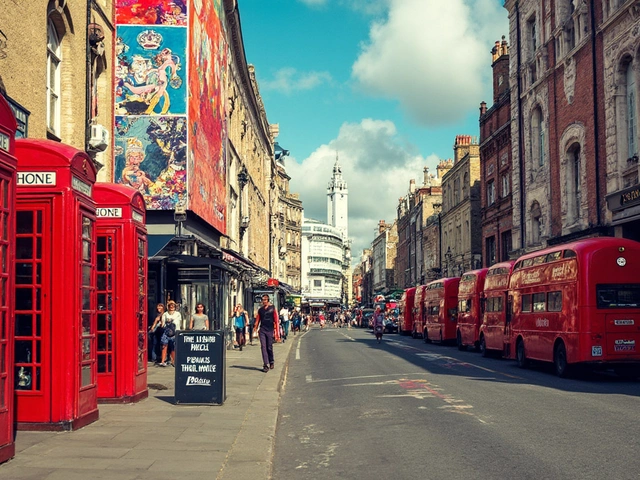Did you notice how a walk through Melbourne’s Federation Square feels a little like wandering through an outdoor gallery? That’s no accident. Land art, with its sweeping gestures and earth-sized ambition, has crept from open deserts right into the heart of our cities. Once the domain of remote locations—think spiral jetties in salt lakes or massive stone wheels set in dusty plains—land art is now leaving bold fingerprints on the way urban designers craft public space. Urban parks, plazas, rooftops, even highway medians are no longer just utilitarian. They’re open-air canvases. The places where we meet, sit, or escape the grind are being carved, shaped, and colored with a thinking that was once radical. Here’s how land art is influencing the cityscapes we live in—and why that’s changing what it means to call a city home.
Land Art: From Far-Flung Installations to Urban Inspiration
Land art kicked off in the late 1960s, when artists like Robert Smithson and Nancy Holt picked up their shovels and started using the earth itself as their paint. Instead of slapping acrylics on a canvas, they moved rocks, dug trenches, and rearranged soil on a scale that made anything in a museum seem tiny. Smithson’s “Spiral Jetty”—a 1,500-foot coil of basalt and earth in Utah’s Great Salt Lake—was built in 1970 and quickly became a cult favorite. Holt’s “Sun Tunnels,” another classic, positioned giant concrete cylinders precisely so the summer and winter solstices would light them up just right. This was art that demanded boots, sunscreen, and a sturdy car.
Something shifted as cities started to burst at the seams. Urban spaces became more than just concrete wastelands or traffic-clogged gaps between buildings. Designers grew inspired by land art’s scale and the way it connected people deeply with place. In the 1990s and early 2000s, you started to see echoes of land art cropping up everywhere from the famous High Line in New York (built on a disused railway) to Melbourne’s Birrarung Marr park, with its rolling hills and indigenous-themed earthworks. These city interventions borrowed the language of land art: big gestures, an obsession with site, planting natural forms right in the urban grid. A bit of wildness, right in the middle of order.
So, why did this shift happen? For one thing, cities got tired of bland plazas and lifeless lawns. Urban planners realized people didn’t just want green space—they craved places that felt alive, even if just for a lunch break. Land art’s approach gave designers permission to “think big,” to carve mounds, plant meadows, and arrange stones in ways that spark curiosity and invite people to explore. Sculptors and urban designers began to team up. You can trace lines from Smithson’s rural spirals right to the grassy amphitheaters and geometric hills now sprinkled across major world city parks. The influence shows in the way spaces flow, too; land art often relies on curves and forms that lead you somewhere, making even the act of walking feel more like a discovery than just a commute.
The land art movement also pumped fresh energy into environmentalism and site-specific thinking in urban design. Artists showed you could shape a space—not just decorate it—and that being sensitive to history, geology, and culture matters. Take London’s Queen Elizabeth Olympic Park. You see manmade wetlands and sculpted earth mounds that also buffer city noise, clean runoff, and house birds. It’s green infrastructure, but it doubles as art you can stroll across. You want raw data? According to a 2023 survey conducted by the European Urban Green Spaces Association, 63% of city dwellers in large European cities rate access to structured natural art installations as “very important” to their daily well-being. That’s not just art for art’s sake. That’s a clear sign people need environments that stir their senses—and urban design is listening.
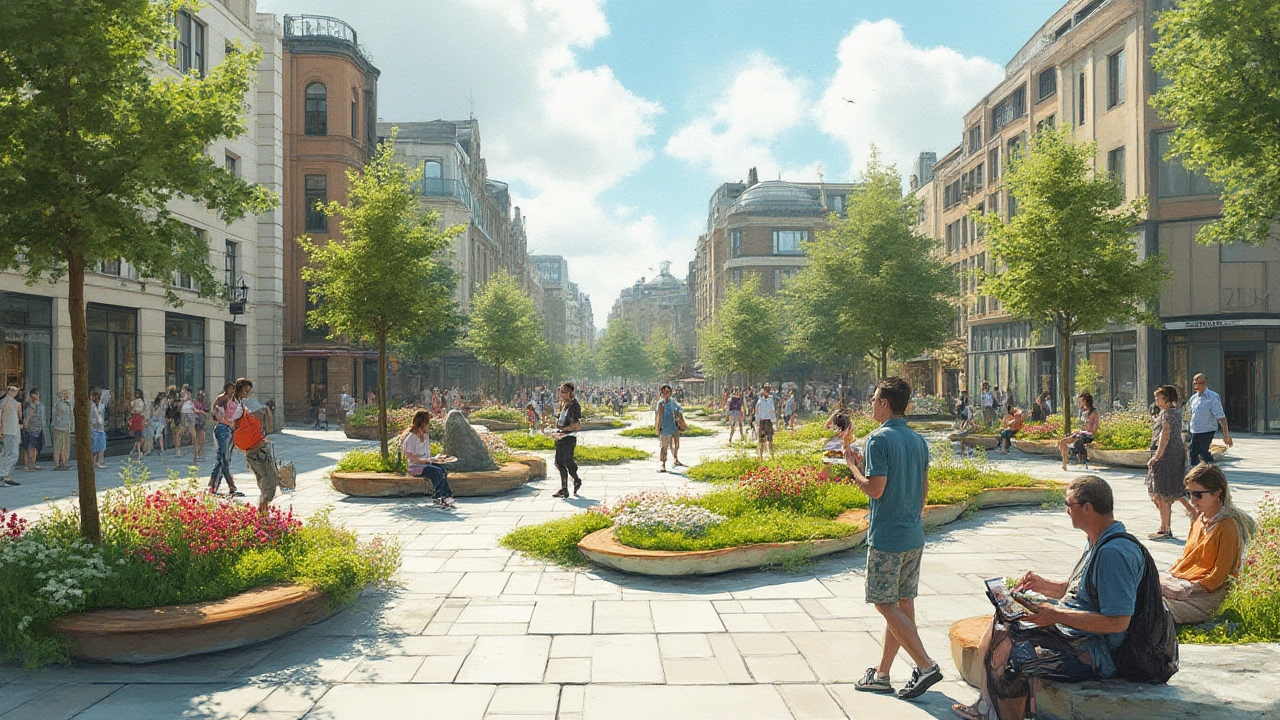
How Land Art Concepts Shape Today’s City Spaces
These days, you can spot the trademark moves of land art in downtown plazas, neighbourhood parks, and rooftop gardens from Berlin to Sydney. Where there once might have been a flat patch of grass and a couple of uninspiring benches, now you’ll find grassy mounds, stone circles, winding paths, and artworks that use earth, water, and plants as their primary material. The goal: to spark joy, wonder, and new ways of interacting with space, even in the thick of high-rise living.
Consider the “Living Water” installation at Yarra Bend Park, Melbourne. Here, natural materials guide stormwater through public art that both cleans and celebrates water’s journey. It draws on the land art tradition by blurring practical function and eye-popping visual form. Or there’s the Olympic Sculpture Park in Seattle, an 8.5-acre transformation of an industrial site into undulating hills, sloped lawns, and site-integrated art, including Richard Serra’s “Wake” and Beverly Pepper’s “Perre’s Ventaglio III.” These pieces don’t just sit in a garden—they’re woven into the paths you walk, the views you glimpse, and the atmosphere you breathe. Talk about merging art and urban ecology.
Not every example is splashy or globally famous. Across France, the “Parc de la Villette” features rolling berms and fragmented axes echoing land art’s fascination with geometry. These aren’t spaces you just pass through—they’re places you want to hang out with friends, exercise, or reflect. Urban planners have noticed: if you want a city park to feel less like a patch of leftover grass and more like a special destination, add some bold forms and land-inspired features.
Melbourne itself is packed with savvy examples. Birrarung Marr, mentioned earlier, folds land art into the heart of the city with earth mounds, contemporary indigenous pieces, and sightlines that play with the Yarra River’s curves. Even the landscaping around Federation Square has subtle mounds and sculpted planes. Many sites use native grasses and stones to amplify that sense that what you’re seeing grew naturally. This idea—that urban space should reflect local geology, flora, and history—comes straight from the land art playbook. Here’s a handy breakdown of common land art techniques and where you’ll spot them in city design, in table form:
| Land Art Technique | Urban Design Example | Impact |
|---|---|---|
| Earth Mounding | Birrarung Marr (Melbourne) | Creates visual interest, buffers noise, becomes a gathering spot |
| Sculpted Water Features | Living Water at Yarra Bend, Diana Memorial Fountain (London) | Cools the space, attracts wildlife, invites interaction |
| Stone & Wood Arrangements | High Line (NYC), Federation Square edges (Melbourne) | Defines pathways, seats, outdoor "rooms" |
| Native Plantings | Queen Elizabeth Olympic Park (London), multiple Melbourne reserves | Promotes biodiversity, reflects local identity |
| Embedded Artworks | Olympic Sculpture Park (Seattle) | Makes everyday journeys feel like an adventure |
These touches create richer experiences, reduce vandalism (it feels cared-for), and often boost visitor numbers. Cities have learned that “interactive” beats “do not touch” every time.
Want to see this at ground level? Try these tips: When you visit a new urban park, ditch the direct path. Follow the curves, climb a hill, or sit for a few minutes on a sculpted bench. Take in how the landscape feels intentionally shaped—where hills create privacy, trees cluster for shade, or winding trails turn a short walk into an urban adventure. If you’re in Melbourne, look for art that tells the story of the land, not just art stuck onto it. This isn’t just decoration; it’s design that’s as much about the journey as the destination.
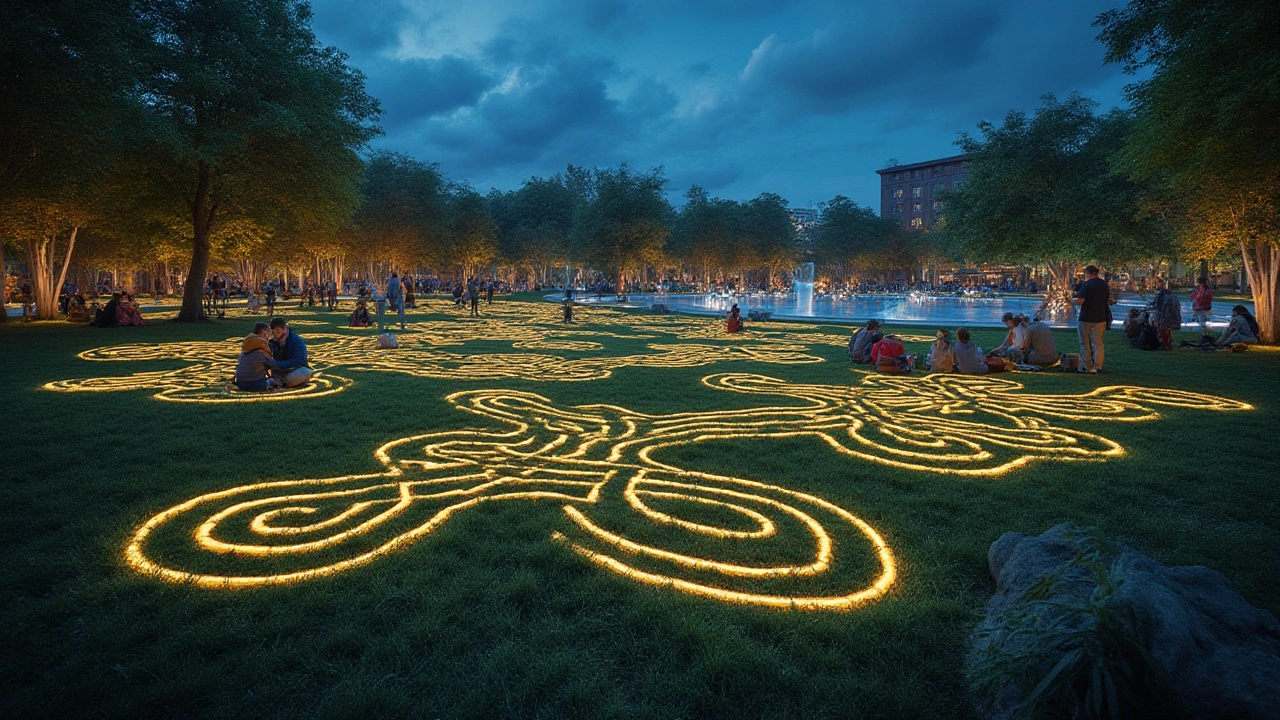
Why Modern Cities Embrace Land Art—and What’s Next
Cities are hungry for identity and community, but the big challenge is this: concrete and tarmac don’t exactly shout “warm and inviting.” That’s why reaching for land art’s playbook isn’t just about style—it solves real urban riddles. Artful mounds and sculpted terrain break up wind tunnels. Ponds and sunken gardens soak up stormwater. Carefully placed stones and earth walls muffle city noise. It’s like sneaking in nature by design.
Statistics from Australia’s Bureau of Infrastructure, Transport and Regional Economics show that urban residents rank “engaging, green public spaces” among their top five quality-of-life factors, just behind transit access and safety. Here’s something wild: in 2022, Melbourne’s Royal Park drew 45% more visitors after a series of land art-inspired upgrades, including earth forms and site-responsive plantings. People lingered longer and used the park at all hours. Parks Victoria tracked a direct jump in social media check-ins, event bookings, and, not so surprisingly, nap counts under the trees.
So, cities have taken a hard look at what works. If a pocket park with raw boulders and hillocks gets people off Zoom calls and into the fresh air, that’s a win. Urban design teams are increasingly tapping local artists and even collaborating with indigenous groups to infuse meaning into public space—the kind you don’t get with mass-produced skate parks or square lawns. Look at Sydney’s Barangaroo Reserve; its rugged sandstone terraces were designed with input from Aboriginal experts, echoing thousands of years of land use while inviting joggers, tourists, and schoolkids alike to play and reflect.
If you’re looking for actionable clues as to how to bring more land art ideas into urban design—here’s the lowdown:
- Keep it authentic—borrow from the geology, flora, and stories native to the area, not just what looks cool on Pinterest.
- Blend function and form—water features should clean and cool, plantings should invite birds, and earthworks should offer protection, not just spectacle.
- Make it interactive. Hills, mounds, or even gently sloped areas naturally attract kids and adults to climb, relax, and explore.
- Layer in art that evolves over time—use materials that weather gracefully, so the space feels alive across seasons.
The real beauty of land art-influenced urban design is that it isn’t finished once the sod is laid or the stones are set. By using *land art* strategies, today’s city spaces grow, wear, and adapt along with the people who use them. Shade trees thicken, native grasses flower, rainwater carves patterns, and footprints invite others to follow. So next time you’re out in a city, see if you can spot those lines between natural landscape and deliberate design blurring just a little. If it feels like the space draws you in, gets you thinking, gives you a story to tell—land art is working its magic in modern urban life.

